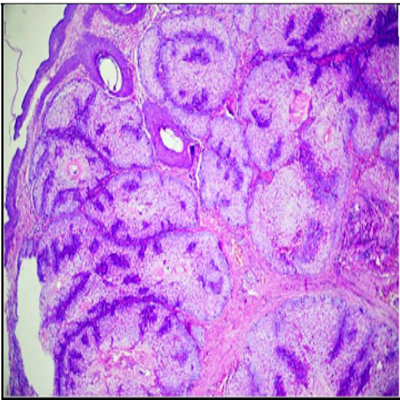Previous Issues Volume 3, Issue 1 - 2018
Sebaceous Adenoma
Anubhav Chauhan
Department of Ophthalmology, Dr Yashwant Singh Parmar Govt. Medical College, Nahan 173001, District Sirmour, Himachal Pradesh, India.
Corresponding Author: Anubhav Chauhan, Senior Resident, Department of Ophthalmology, Dr Yashwant Singh Parmar Govt. Medical College, Nahan, District Sirmour, Himachal Pradesh, India,
E-Mail: [email protected]
Received Date: 21 Sep 2018 Accepted Date: 28 Sep 2018 Published Date: 01 Oct 2018
Copyright © 2018 Chauhan A
Citation: Chauhan A and Singh S. (2018). Sebaceous Adenoma. Mathews J Ophthalmol 3(1): 021.
Sebaceous adenomas are rare tumours. They are benign and slow-growing in nature and usually mistaken for basal cell and sebaceous carcinoma. We report a case of sebaceous adenoma in a 65 year old female.
Sebaceous; Female; Excision.
CASE
A 65 year old female (figure 1) presented to the department of ophthalmology with a history of mass/growth in the left eye for the past three months which was progressively increasing in size. There was no other ocular complaint. There was no other significant medical, surgical, personal, family or drug abuse history nor previous history of ocular disease/trauma/ malignancy. The patient was non-smoker, non-alcoholic and vegetarian. Her general physical and systemic examination was within normal limits. Her best corrected visual acuity was 6/9 in both the eyes; pupillary reactions, ocular movements, intraocular pressure and fundus examination were normal. Torch light and slit lamp examination of the left eye revealed‘’an upper lid margin exophytic nodular mass, 12 >< 11 mm, whitish in colour with crusting, ulceration and prominent vasculature.
A probable diagnosis of sebaceous carcinoma was made. Preoperative blood investigations in the form of complete blood count, liver function test, renal function tests and human immunodeficiency virus were normal. An excisional biopsy with clear resection margins was performed. Postoperative topical and systemic antibiotics were given. Microscopic examination from the biopsy (figure 2) demonstrated ‘’ lobules of sebaceous gland with dark & light areas. The cytoplasm showed lipidic vacuoles. Mitotic figures or hyperchromasia was not seen. There was no evidence of any atypia in the biopsy submitted.’’ The findings were consistent with sebaceous adenoma. Radiological investigations of the chest and abdomen were performed as this condition is sometimes associated with systemic/visceral malignancy (Muir-Torre syndrome). Facility for immunohistochemical markers were not available with us. Patient is on regular follow-up with us for the past three months and her ocular and systemic examination is within normal limits to date.
DISCUSSION
Sebaceous adenomas are a RARE benign neoplasm of the epithelial tissue. They can be solitary or multiple, and are usually found on the head or neck region. These lesions are well demarcated with irregular lobules within the papillary dermis. Some authors suggest that ‘‘sebaceous adenomas’ are actually ‘‘sebaceous carcinomas. [1] Sebaceous adenomas were first reported by Van Walbeek in 1949. These present as tan, pink, or yellow nodules or papules. In the eyelid, they may involve the glands of Zeiss or meibomian glands. They commonly manifests around 60 years of age. The general features of sebaceous adenomas have been reported as follows: approximately 5 mm in greatest dimension, maintaining a lobular and organoid architecture, and often showing connection with or replacement of the overlying squamous epithelium. Sebaceous adenomas show variably expanded basaloid cells, more than the normal two-cell layers seen in normal sebaceous glands and sebaceous hyperplasia. [2]
Histologically, /the differential diagnosis of sebaceous adenoma includes clear cell variations of eccrine, melanocytic, keratinocytic or xanthomatous lesions and renal cell carcinoma. The lesions show a characteristic bubbly or multivacuolated cytoplasm and crenated nuclei of mature sebocytes coupled with the germinative cells. Immunohistochemical staining may be helpful for particularly difficult lesions. [3] Muir-Torre syndrome (MTS) should be ruled out in cases of sebaceous adenomas. Diagnosis of the syndrome is based on the presence of at least one sebaceous neoplasm and a visceral malignancy, or alternatively multiple keratoacanthomas associated with visceral malignancies and a family history of MTS.The malignancies most commonly seen are colorectal, genitourinary, and breast carcinoma.[4]
The management of sebaceous adenoma consists of excision en toto. With complete excision, recurrence rates would be very low. [5]
REFERENCES
- Terrell S, Wetter R, Fraga G, Kestenbaum T, et al. (2007). Penile sebaceous adenoma. Journal of the American Academy of Dermatology. 57(2): S42-S43.
- Takayama K, Usui Y, Ito M, Goto H, et al. (2013). A case of sebaceous adenoma of the eyelid showing excessively rapid growth. Clinical Ophthalmology. 7: 667-670.
- Shalin SC, Lyle S, Calonje E and Lazar AJ. (2010). sebaceous neoplasia and the Muir–Torre syndrome: important connections with clinical implications Histopathology. 56(1): 133-147.
- Abbas O and Mahalingam M. (2009). Cutaneous sebaceous neoplasmsas markers of Muir-Torre syndrome: a diagnostic algorithm. J Cutan Pathol. 36(6): 613-619.
- Welch KC, Papadimitriou JC, Morales R and Wolf JS. (2007). Sebaceous adenoma of the parotid gland in a 2-year-old male. Otolaryngology–Head Neck Surg. 136(4): 672-673

